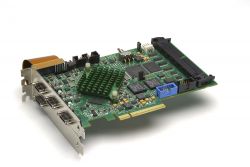BotEyes Telepresence Robot new features
Now the BotEyes robot users can zoom in and out of a remote scene
RLDA Ltd., the Russian technology company announced today that all the BotEyes telepresence robots bought before and after this date can use zoom-in and out robot features. It is important to stress that the price of the robot remains the lowest in the industry.
Native scaling is not supported by all tablets, and if it is supported by a tablet, it may not be supported by the browser. For these reasons, both types of scaling are implemented in the BotEyes telepresence robot: native and software, in JavaScript. Depending on the selected tablet and browser, the user can choose the best scaling method for him.
To reduce the load on the processor, we made it possible to reduce the video frame rate after zooming in the video. This does not affect the convenience of using the robot, since the device is most often used to examine stationary objects (a blackboard, a sheet on a table, equipment parts). At the same time, the frame rate can be increased if the user has a tablet with large operational memory.
Since the video zooming factor depends on the resolution of the camera, and the rear camera of most tablets has a resolution almost 2 times higher than the front one, we made it possible to quickly switch cameras in the robot. To get the maximum magnification, use the rear camera.
Another problem associated with programmatic magnification is automatic focus pointing. The fact is that with the software zooming method, the focus criterion uses the entire field of the matrix, while only part of it increases. Therefore, it may turn out that the focus is not set to the part of the image that we have enlarged, and it turns out to be blurry.
As usual, the longer the camera is stationary, the clearer the image becomes. There are two reasons: WebRTC automatically increases the bandwidth of the communication channel and the tablet adjusts to focus.
You can see this in practice using the reference to free test drive. Follow this link.
About RLDA, Ltd.
The BotEyes telepresence robot is designed and mass-produced in the Research Laboratory of Design Automation, Ltd. (RLDA, Ltd.). The brand of RLDA company is "RealLab!". The official site is www.reallab.com.
The company's goal has always been meeting the needs of society on the basis of the latest achievements of science and technology. The interests of buyers, we always put in the first place. Ensuring high-quality products and customer service is our priority. The main products of the company are telepresence robots BotEyes series, I/O modules RealLab!, programmable logic controllers, sensors with RS-485 interface, as well a process control system. Product catalog of more than 100 products with a term shipment of not more than 5 days.
Featured Product

BitFlow Introduces 6th Generation Camera Link Frame Grabber: The Axion
BitFlow has offered a Camera Link frame grabbers for almost 15 years. This latest offering, our 6th generation combines the power of CoaXPress with the requirements of Camera Link 2.0. Enabling a single or two camera system to operate at up to 850 MB/S per camera, the Axion-CL family is the best choice for CL frame grabber. Like the Cyton-CXP frame grabber, the Axion-CL leverages features such as the new StreamSync system, a highly optimized DMA engine, and expanded I/O capabilities that provide unprecedented flexibility in routing. There are two options available; Axion 1xE & Axion 2xE.
The Axion 1xE is compatible with one base, medium, full or 80-bit camera offering PoCL, Power over Camera Link, on both connectors. The Axion 2xE is compatible with two base, medium, full or 80-bit cameras offering PoCL on both connectors for both cameras.
The Axion-CL is a culmination of the continuous improvements and updates BitFlow has made to Camera Link frame grabbers.
